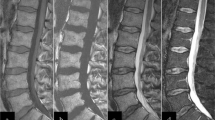Abstract
The appearance of hematopoietic marrow in magnetic resonance (MR) imaging is variable and differences between normal and pathologic marrow may be subtle. To aid in the evaluation of this problem, we reviewed 82 consecutive pelvic MR examinations in men with no evidence of osseous metastases. Images were evaluated with regard to the overall fraction of residual hematopoietic marrow present and the characteristics of this marrow. The patient population in our study was older (mean age 66 years) than the patient populations in previous papers documenting normal marrow patterns. The overall amount of hematopoietic marrow present was less in this older patient population, with 80% of patients having less then 40% residual hematopoietic marrow. A consistent pattern of morphologic change was noted as hematopoietic marrow converted to fatty marrow with increasing age. Initially, hematopoietic marrow tended to appear diffuse, heterogeneous, and with poorly defined margins on MR imaging. As conversion to fatty marrow continued, hematopoietic marrow became more focal and sharply defined, usually in the form of islands of residual hematopoietic marrow. Periarticular hematopoietic marrow predominated in the sacroiliac region (72% of patients) with little residual hematopoietic marrow noted in the symphysis pubis (5%) and hip joints (30%). Hematopoietic marrow persisted longer in juxtacortical locations (87%), was always symmetric (100%), remained less intense than fat on T2-weighted images (100%), and usually had a central focus of fat (98%). These morphologic criteria may be of value in establishing the MR appearance and patterns of marrow in the pelvis, and in the recognition and confident diagnosis of foci of hematopoietic marrow.
Similar content being viewed by others
References
Moore SG, Sebag GH et al. Primary disorders of bone marrow. In: Cohen MD, Edwards MK, eds. Magnetic resonance imaging of children. Philadelphia: Decker; 1990: 765–824.
Vogler JB, Murphy WA, Bone marrow imaging. Radiology 1988;168:679–693.
Moore SG, Dawson KL. Magnetic resonance appearance of red and yellow marrow in the femur: spectrum with age. Radiology 1990;175:219–223.
Moore SG. MR imaging of bone marrow. In: Kressel HY, Modic MT, Murphy WK, eds. Syllabus; special course MR, 1990: 219–228.
Kricun ME. Red-yellow marrow conversion: its effect on the location of some solitary bone lesions. Skeletal Radiol 1985;14:10–19.
Dawson KL, Moore SG, Rowland JM. Age-related marrow changes in the pelvis; MR and anatomic findings. Radiology 1992;183:47–51.
Ricci C, Kang YS, et al. Normal age related patterns of cellular and fatty bone marrow distribution in the axial skeleton: MR imaging study. Radiology 1990;177:83–88.
Zimmer WD, Berquist TH, McLeod RA, et al. Bone tumors: magnetic resonance imaging vs computed tomography. Radiology 1985;155:709–718.
Moore SC, Gooding CA, Brasch RC, et al. Bone marrow in children with acute lymphocytic leukemia: MR relaxation times. Radiology 1988;173:335–339.
Mitchell DG, Rao VM, Dalinka M, et al. Hematopoietic and fatty bone marrow distribution in the normal and ischemic hip: new observations with 1.5 T MR imaging. Radiology 1986;16:199–202.
Dooms GC, Fisher MR, Hricak H, Richardson M, Crooks LE, Genant HK. Bone marrow imaging: magnetic resonance studies related to age and sex. Radiology 1985; 155:429–432.
Rao VM, Fishman M, Mitchell DG, et al. Painful sickle cell crisis: bone marrow patterns observed with MR imaging. Radiology 1986;161:211–215.
Daffner RH, Lupelin AR, Dash N, et al. MRI in the detection of malignant infiltration of bone marrow. AJR 1986;146: 353–358.
Cohen MD, Klutte EC, Buehner R. et al. Magnetic resonance imaging of bone marrow diseases in children. Radiology 1984;151:715–718.
Weinreb JC. MR imaging of bone marrow: a map could help. Radiology 1990;177:23–24.
Van Dyke D. Similarity in distribution of skeletal blood flow and erythropoietic marrow. Clin Ortho 1967;52:37–51.
Piney A. The anatomy of the bone marrow. Br Med J 1992;2: 792–795.
Custer RP. Studies of the structure and function of bone marrow. Variations in cellularity in various bones with advancing years of life and their relative response to stimuli. J Lab Clin Med 1932;17:960–962.
Schweitzer ME, Levine CD, Mitchell DG, et al. Bullseyes and halos: useful MR discriminators of osseous metastases. Radiology. 1993;188:249–252.
Frank JA, Ling A, Patronas N, Carrasquillo JA, et al. Detection of malignant bone tumors: MR imaging vs scintigraphy. AJR 1990;155:1043–1048.
Kattapuram SV, Khurana SS, Scott J et al. Negative scintigraphy with postive magnetic imaging in bone metastases. Skeletal Radiol 1990;19:113–116.
Author information
Authors and Affiliations
Rights and permissions
About this article
Cite this article
Levine, C.D., Schweitzer, M.E. & Ehrlich, S.M. Pelvic marrow in adults. Skeletal Radiol. 23, 343–347 (1994). https://doi.org/10.1007/BF02416990
Issue Date:
DOI: https://doi.org/10.1007/BF02416990




